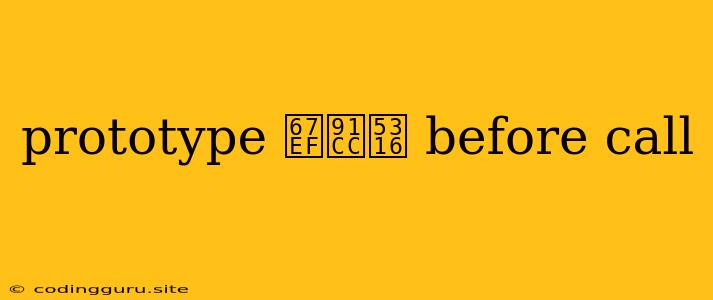Understanding Prototypes, Currying, and call() in JavaScript: A Comprehensive Guide
In the realm of JavaScript, grasping the concepts of prototypes, currying, and call() is crucial for building robust and efficient applications. These fundamental techniques empower you to write cleaner, more reusable code, fostering a deeper understanding of how JavaScript functions and objects interact. Let's delve into each of these concepts and explore their practical applications.
Prototypes: The Backbone of JavaScript Inheritance
At its core, JavaScript is a prototype-based language. This means that objects inherit properties and methods from their parent objects, establishing a hierarchical chain known as the prototype chain. Understanding prototypes is essential for comprehending object-oriented programming in JavaScript and mastering inheritance.
What are Prototypes?
A prototype is simply an object that acts as a template for other objects. When you create a new object, it inherits properties and methods from its prototype. Consider the following example:
function Animal(name) {
this.name = name;
}
Animal.prototype.speak = function() {
console.log("Generic animal sound");
};
const cat = new Animal("Whiskers");
console.log(cat.name); // Output: Whiskers
cat.speak(); // Output: Generic animal sound
In this example, Animal is a constructor function, and its prototype (Animal.prototype) defines the speak method. When we create a new cat object using the Animal constructor, it inherits the speak method from the prototype.
How Does Inheritance Work?
When you try to access a property or method on an object, JavaScript first checks if it exists directly on the object itself. If not, it traverses up the prototype chain, checking each prototype in turn until it finds the desired property or method. This mechanism allows objects to inherit behavior from their ancestors, promoting code reuse and simplifying object creation.
Currying: Transforming Functions
Currying is a functional programming technique that allows you to transform a function that takes multiple arguments into a sequence of nested functions, each taking a single argument. It's like breaking down a multi-course meal into smaller, individual portions.
What is Currying?
Currying allows you to create functions that are more flexible and reusable. Instead of accepting all arguments at once, a curried function takes one argument at a time and returns a new function that expects the next argument. This process continues until all arguments are supplied.
Example of Currying
function add(x) {
return function(y) {
return x + y;
};
}
const add5 = add(5); // Curried function to add 5 to any number
const result = add5(3); // result is 8
In this example, add is a curried function. When called with add(5), it returns a new function (add5) that takes a single argument and adds 5 to it.
Benefits of Currying
-
Partial Application: Currying allows you to create partially applied functions. For instance,
add5is a partially applied function ofadd, waiting for the second argument. -
Improved Code Readability: Currying can make your code more readable and understandable, especially when dealing with functions that take many arguments.
-
Flexibility: Curried functions can be easily composed and combined to create more complex functions.
call() Method: Changing the this Context
The call() method is a powerful tool that enables you to dynamically change the context (this) of a function call. This is particularly useful when you want to borrow methods from other objects or manipulate the this value within a function.
What is the this Keyword?
In JavaScript, the this keyword refers to the object that is currently executing the code. The value of this depends on how a function is invoked. For instance, in a regular function call, this typically refers to the global object (or undefined in strict mode). However, call() allows you to explicitly control the this value.
Example of call()
function greet(message) {
console.log(`${message}, ${this.name}!`);
}
const person = {
name: "Alice",
};
greet.call(person, "Hello"); // Output: Hello, Alice!
Here, greet is a function that expects a message as an argument. When call(person, "Hello") is invoked, the this value inside greet is set to the person object, allowing us to access its name property.
Uses of call()
-
Borrowing Methods: You can use
call()to borrow methods from other objects. For example, you might useArray.prototype.slice.call(arguments)to convert anargumentsobject to an array. -
Changing
this:call()provides precise control over thethiscontext, allowing you to manipulate it as needed. -
Extending Objects:
call()can be used to extend objects by adding properties and methods.
柯里化 (Currying) and call() Together
Combining currying and call() can lead to powerful and flexible code. Imagine a scenario where you want to create a function that takes an object and a property name, returning the value of that property.
function getProperty(obj) {
return function(prop) {
return obj[prop];
};
}
const myObj = {
name: "Bob",
age: 30,
};
const getName = getProperty(myObj);
const name = getName("name"); // Output: Bob
// Alternatively:
const age = getProperty(myObj).call(myObj, "age"); // Output: 30
In this case, getProperty is a curried function that takes an object as the first argument and returns a function that expects a property name. Using call(), we can dynamically set the this context within the returned function to the original object, allowing us to access its properties.
总结 (Conclusion)
Understanding prototypes, currying, and call() in JavaScript is essential for mastering object-oriented programming and functional programming techniques. These concepts empower you to write cleaner, more reusable, and more flexible code, making your JavaScript journey smoother and more enjoyable. By leveraging these powerful features, you can unlock the full potential of JavaScript and create truly remarkable applications.
